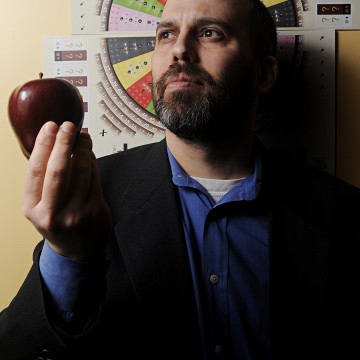It’s an article of faith to the DWP that everyone brings a unique POV to the Tabletop. So we thought it’d be a neat idea for the four of us to (a) play a game together and then (b) go off on our ownsomes and write up our separate takes on said game experience. This article represents the proof-of-concept of this idea, and for now we’re going to call it 4-Way Intersection.
What we’re hoping is that, by looking at a game from multiple angles you’ll get a fuller, more three-dimensional sense of the experience.
Our first 4Way is about Bus, designed by Jeroen Doumen and Joris Wiersinga and published by Splotter in 1999. This is the team that has formed the backbone of Splotter for over 20 years, designing and publishing games such as Roads & Boats (1999), Antiquity (2004), and Food Chain Magnate (2015). The term Splotter Game refers to those heavy behemoths and others like them; Bus is quite the anomaly in their catalog.
Alice C

Bus is one of those games that floats around the back of your brain. You know it’s a classic, you’ve heard it’s weird, but you’ve never played it. It’s bus-route-building with a sprinkling of time travel, you hear, and the original board was much better/worse than the re-released one. You look it up and discover copies start at $100 and you think, “Eh, I’ll play it someday, maybe.” Then your buddies hatch a scheme to play it and everyone write a review in their own voice and suddenly someday is today! The new board is Right There in front of you, the routes cleanly rendered, the passengers patiently waiting, the time travel not so much sprinkled as dropped casually onto the action-selection side of the board.
I was charmed by Bus. Also perplexed, trying to remember and predict where the passengers needed to get to next and so, so pleased to play with some of the DWP crew, but we’ll get to that. Bus is really a straight-forward route-building and pick-up-and-deliver game—how many road bits you can place, as well as how many passengers you can move or buildings you can place, is slightly complexified (based on the number of buses the person with the most out has), but truly, it’s almost like a condensed Ticket to Ride or Maglev Metro. What makes it perplexing is the time travel option, as you might expect. The passengers follow a predictable path: they first want to go home (anyone’s home, they’re not picky), then they want to go to work (again, any work will do, their skills are transferable), and finally they want to go have a drink at the pub (also any pub, Yelp be damned). Home, work, pub, without fail. Unless someone stops time so they can score points for a location the passengers aren’t currently longing for. Truly, a responsible use of the technology. Plus, a player could choose to claim the time travel spot and then not use it—a kind of temporal sabre-rattling that messes with everyone else’s decision-making.
Bus is spicy. It’s snappy, concise, and swingy. I love it.
What I don’t love is Tabletop Simulator, especially on my Mac—the interface is not intuitive for non-veteran PC gamers and the main screen does not divulge anything about how to use it, leading to my claiming the character of cranky grandma during our play. I can’t complain too much, however, as it allowed the four of us in three different cities to play a classic, spicy game together. I’d never played a single game with David W, living as we do in different countries, and hadn’t played with Bailey D for months. Taylor G I play with all the time, but we rarely get to play with multiple high-level players and what a treat it was! The jokes, the under-the-breath thinking aloud, the irritated “really?” and “you took my spot!”—exactly what one would want from playing Bus irl. Ten out of ten after-work-beers-you-weren’t-expecting for Bus itself, 5 out of 10 for the digital implementation, and 12 out of 10 for the company.
Bailey D

I want to keep my thoughts on Bus as tight and concise as the game itself. Bus may be the most fat-free game out there: no fluff, no extras, no mechanics or ideas that don’t have a place. The worker placement spots are competitive and always yearned for by somebody; however, because the spots are not activated as soon as the workers are placed on them, there’s plenty of room for shenanigans if your ideal spot gets taken. “Oh, Taylor took more bus routes? Well, if I take building placement then I can cover up the spots she’s going to be building to with bad buildings and then build toward them myself next round!”.
I just can’t get over how a game with so few actions available can be so in-depth and also so freaking mean. And it’s not even that the game itself is mean, but if players are not mean to one another and it’s played as an efficiency Euro, then the game can be decided pretty quickly. That, combined with the fact that players only have to play two workers each round but can play more than that, means if players do not attack those with more pawns and those that are isolated from the rest, they may as well call the game.
This is what happened with us. I was holding back as many pawns as possible, but had to make a swing for it at some point. And when I did, I was in the lead. But, our dear Alice was all alone in her corner of the board with two action pawns all to herself so that she could come back and win, as she was not in competition with anyone, for action spots or for the board.
I know it’s getting harder and more expensive to play this game, but if you are in the market for the simplest, meanest game out there, play Bus. You won’t regret it.
Taylor G

Reader, fair warning: Drink your apple juice every time one of us says “Wibbly Wobbly Timey Wimey”. We’re playing Bus.
1999 – a great year for gaming. Lost Cities, Apples to Apples, the One True Doctor Reiner Knizia’s Ra. And, one of two games published that year by the at-the-time new-to-market design company, Splotter Games, Bus. Beep! Beep! This turn-of-the-millenium classic is often quoted as one of the first games to use the worker placement mechanism. Workers are placed at the beginning of each round and then, following the placement of all players’ workers, the actions are carried out on the game map. The timey-wimey twist is that a player could take the option to stop time (and so changing which map elements will score points), but their decision isn’t revealed until after players have set their workers’ tasks.
My love of track-laying, pickup-and-deliver games is well documented. And anyone who has ever gamed with me knows I love a good worker placement. Truly, it is only because I was entering kindergarten when Bus was published and now a body needs about 200 American Dollars to snag a copy that I haven’t played before. Everything about this game is right up my alley. WEIRD concept meets crunchy strategy with tight, low-scoring play. Perfect.
Except.
There is a certain, sad joy that comes to me when I discover games that I really like, don’t own, and won’t have many opportunities to play because they require more than 2 people. This feeling definitely came up while playing Bus with my DWP companions. I loved it the whole time and I was sorrowful that I probably will not get to play this game often in the future. These feelings are only exacerbated by playing in digital form rather than around a physical table. It’s hard to stay present and enjoy the play time when the players are not even in the same country. Several times throughout I was on a different web page or even making up my own mini game with the Tabletop Simulator flick action and the disused pieces off to the side. I emotionally vacillated between giddy satisfaction of playing a four-player game with the exact humans I wanted to play with and sad boredom as I spent yet another night gaming in front of a screen instead of around a real table with my people.
In terms of actual play, I will again point to the digital experience as being inferior for developing and sticking to a good strategy for the entire length of a game. I just don’t have the attention span to make a strategy engine go when I’m playing on the computer. There was a specific moment in our DWP match in which Alice made a brilliant decision to stop time, forcing myself, David, and Bailey to take no points for the round. Had I been paying attention, I probably could have eked out a couple more points by noticing that was A’s best move and reacting sooner.
Digital table-top woes aside, I would definitely play Bus again. I would even consider investing a large sum of money to own a used copy (though probably not $1699, the current asking price on an Ebay listing for one of the original 30 games hand-produced by the Splotter crew in 1999). Bus’s wholesome concept – public transit meets time travel – and clever mechanics get a big thumbs up from me.
David W

So apparently (sorry, Taylor) I owned the original Bus at some point in my life but I don’t remember owning it or playing it? Just one of several downsides to TMFG Syndrome. (The main one is reaching the point when your collecting threatens to overpower your entire living space. Look up the Collyer brothers sometime.)
Anyway when I sat down to play this with my new gaming buddies A, B, and T I was pleasantly surprised by how fresh it felt. Keep in mind, this is a game published in 1999. BGG was just a widdle baby and games like this were still found only in dusty “hobby” stores.
What strikes me now about Bus is that, of its three main mechanics, two (worker-placement/action-selection and pick-up-and-deliver) are here in plain sight in 1999. (The third main mechanic is route-building, which has been around at least as long as crayon rails games.)
Yet Caylus (2005) is usually credited with being the first worker-placement game and Age of Steam (2002) gets the nod for popularizing pick-up-and-deliver. But Bus was there first, and with neat twists on both!
In the case of worker-placement, Bus forces players to consider when to place their actions as well as where: certain actions such as route-building are activated in reverse order of placement but with increasing power. This introduces a push-your-luck aspect to things, as you have to decide whether to settle for being last at the trough in exchange for being able to claim more routes.
But also, Bus has an absolute limit–twenty–on the number of actions you get to take in the entire game. This introduces a kind of tension I don’t see in many other worker-placement games, in that each player has to set their own pace. It’s so tempting to take more actions early in the game, but then the player who manages to reach the later rounds with extra actions in pocket can usually make up a lot of lost ground–which is in fact what happened in our game, as Alice carved out a victory after everyone else had shot their bolt. It’s such an elegant catch-up mechanic hiding in plain sight.
In the pick-up-and-deliver part, Bus also introduces time as another factor in the decision-space. All the citizens of Bustown go through a cycle of wanting to move from home to work to the pub and home again. Players need to constantly monitor who wants to go where and why–or else risk having “your” dude leeched away by someone else’s route (as Bailey discusses in her writeup). And then there’s the whole mechanism whereupon a player can freeze time and muck up everyone’s carefully-laid plans. It’s Wibbly-Wobbly Timey-Wimey (take a sip of apple juice!) in-your-face goodness.
The most elegant thing about Bus is that underneath all this brain-burny stuff is a very simple scoring mechanism: you get one point for each citizen you transport on your line, and subtract a point for each time-stop you activate. And that’s it. None of this point-salad multiple-paths-to-victory AAA bullshit. It’s focused, it’s elegant, and it’s darned good for a 20+ year-old game.
Comments
No comments yet! Be the first!